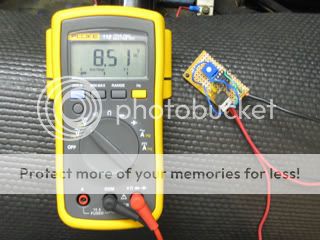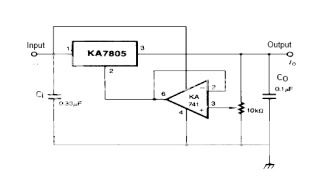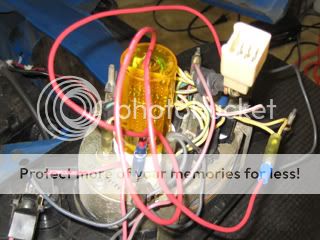Chevy LUV instrument voltage regulatorEver since I’ve had the truck my gauges have read low; at temperature, the temperature gauge never gets where the shop manual indicates it should and at half tank on the gas gauge I only put in 2 or 3 gallons. All indications are that it is the instrument voltage regulator (IVR) that is acting up. On the Series 1 LUV, the instruments are simple devices that work by measuring the current flowing through an external circuit (the gauges and sending units) with the driving potential of 8.5 V. That is, apply 8.5 V and the gauges are supposed to work properly; this of course assumes the resistance of the gauges and associated wiring has not changed in the life of the truck. In the LUV, the voltage regulator is a bimetal device that flips the battery voltage on an off at the correct frequency to average 8.5 V. This bimetal device is 70s technology and is also used in various Fords (and possibly other GM). I suspected my stock regulator was malfunctioning.
After getting an extra instrument panel from Luvrv8 (Thanks!) I was able to do some playing around. I started by swapping the regulator from the spare panel. No luck, gauges read the same. It and my own regulator appeared to be outputting the same voltage, which was an average of 6.5 V according to my meters. No wonder my gauges were reading low. The regulators are supposed to be adjustable, but the screw on mine was potted to the point where I couldn’t turn it, and the spare one didn’t do much adjusting. So I decided to hell with it, I’ll build a circuit to replace it and bring the thing up to the 21st century, and lastly to hopefully have gauges that tell me something useful.
I’m not the first to build a replacement, e.g.
http://www.turbotbird.com/techinfo/ivr/ ... te_IVR.htmhttp://www.kansasselectproducts.com/ser ... TOR/Detailand I also suggested building a replacement once before
viewtopic.php?f=5&t=19472&p=141837&hilit=instrument+voltage+regulator#p141837Now, in the above links they were building for 5 V, which is the approximate Ford voltage. The LUV requires 8.5 V nominally, so I decided to build the following circuit, which I borrowed from the datasheet for the 7805 regulator. It gives adjustable voltage from 7 V up to 2 volts below your supply voltage (so 7-11.8 V assuming 13.8 V for battery voltage when running). Here is a photo and schematic of the completed circuit,


and I packaged it using an old pill bottle. One, for convenience, two, for small size, and three because I figured out I could mount it to the instrument panel like this:

It’s detachable for adjustment but will stay attached when it’s all set. The ground screw holds the ground wire and the white plastic cap to the gauge module. The orange plastic shell attaches in the usual manner to the cap, and it stays attached. The correct connectors were attached to the regulator to mate up with the instruments. The voltage was then regulated to 8.5 V, and I went for a test drive, and the gauges all read the same


You can see that the fuel gauge is reading less than ½, when actually it’s about ½, and the temperature is reading as not warmed up when it was. The temp should be in the white zone when the truck is warmed up. Not deterred, I then regulated the voltage to a level where the gauges would read “correctly,” the most important being the temperature gauge. On my truck that turned out to be 9.78 V.

The end result is properly functioning gauges, without electrical hacking of any kind. The new regulator doesn’t vary a tenth of a volt under load, and should last for a while. The regulator is rated for 1 amp, and I calculate that the total current flowing in the circuit is in the 300 mA range, so the regulator should live and also I don't think I need to heat sink it (which I didn't).
If the gauges go out of spec again in the future, I can simply adjust the regulator. The parts for it I bought at the electrical engineering stockroom at school, but you can get 7805 regulators and 741 op-amps at Radio Shack as well, for pretty cheap. I probably spent a total of about $10 for this, partially owing to the fact that I already had a circuit board, wire, and soldering equipment.
The only drawback I have found is that the fuel gauge doesn't rise fully as quickly with the new setup, likely due to the fact that with the old regulator it sticks closed when you start the truck up, because it has to get hot to work. So in the old setup, 12V was fed to the fuel gauge first, then "regulated" voltage, whereas now I feed 9.78 V only and the gauge doesn't rise as quickly.



